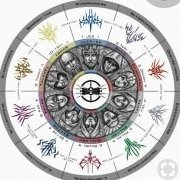Leaderboard
Popular Content
Showing most liked content on 11/28/12 in all areas
-
We know that gemstones encased in glass spheres form the currency on Roshar, and we get a few bits of info regarding their relative worth. I thought it might be interesting to put that together and try to figure out as much of the currency system as we can. What we know for certain: 1. There are three denominations of each gem: chips, marks and broams. 2. Diamonds are the least valuable. 3. Emeralds are the most valuable. 4. 5 chips make a mark. 5. The relative value of gems, at least theoretically, is related to their use in Soulcasting, since we're told in the first Shallan PoV that emeralds are most valuable because they can be used to make food. 6. A clearchip (diamond chip) is the price of one loaf of bread; this is the smallest denomination of money. 7. An emerald broam, the largest denomination, is worth 1,000 diamond chips. 8. A bridgeman is paid 2 diamond marks a day. The slaves, like Kaladin, get half of that. 9. A sailor earns one firemark (ruby) a week, i.e. every 5 days. 10. There are 5 diamonds to a garnet 11. A garnet is worth less than a sapphire What we can guess: 1. Sapphires are relatively cheap, since we see them a lot in the bridgemen scenes, and also because, when Shallan buys her books, the final price is "three emerald broams and two sapphire". This implies that two sapphires are still worth less than one emerald. 2. If bridgemen (non-slaves) get 2 diamond marks a day, then they get 10 per week. Sailors get one ruby mark per week. This means that rubies are at least 10 times more valuable than diamonds, and probably more, since I can't imagine sailors being paid less than bridgemen. This implies that rubies are among the more valuable gems. 3. We hear a lot about Soulcast stone barracks as a means of defending against highstorms. This seems to be a core function of the ardents with the army, and therefore implies that topaz would be pretty valuable. What we have questions about: 1. If the value of gems were only affected by Soulcasting use, why is diamond the least valuable? Crystal/glass seems more useful than air, or smoke, or oil. Why are rubies valuable? Incinerating thieves is certainly badass, but is that really what the ardents use them for? 2. In a flashback, Dalinar sees a Radiant heal a woman using a topaz and a heliodor, corresponding to flesh and bone. If the ardents have healing fabrials, why wouldn't heliodor be among the most valuable gems? One would think the wealthy would pay out the wazoo for miraculous healing. 3. How much more valuable are infused gems than dun ones? At one point, Shallan says they're just as valuable, and the apothecary Kaladin goes to accepts them (after verifying they're real), but at another point we hear about moneychangers charging fees to infuse spheres. 4. On a related note, how long do spheres keep their charge? Do larger ones hold their charge longer? Do they hold more stormlight? Please post what you can to this, I'd love to see an accurate "exchange rate" chart!1 like
-
The first one's been answered in the recent Q&A, IF. Roshar has only that one supercontinent. There is other "stuff" out there in the oceans though. If I'm remembering right, there are latitude markings on one of the maps, and the continent is in the southern hemisphere, which makes sense, considering the "Frostlands" are in the south and Iri and the Reshi Isles, in the north, are tropical.1 like
-
Hi -- Long time lurker, first time poster. While at Dragon*Con, during Magic:tG with Brandon, I was able to get an answer to one of the question on the big list of questions. Here is the question: Why are invested objects like metalminds and Hemalurgic spikes able to be Pushed and Pulled on, but Shardblades and Shardplate, which are also invested, are not susceptible to Pushing and Pulling? His answer was complex, I took notes, but didn't get recorded audio. I am going to try to explain as best as my notes and memory support. There were a few concepts that he outlined in answering this question. 1.) The ability to push/pull an invested object is predicated to the amount/power of the investiture 2.) Further, invested objects also gain resistance to pulling/pushing based on proximity to soul possibly via the soul. An example given is that A hemalurgic spike touches the blood of the person, and from there is now part of both the Spiritual Realm and the Physical Realm. This provides what Brandon termed a kind of "soul interference," based on its proximity to the soul. This further explains why Vin required more than normal power to push/pull the metalminds from the Lord Ruler, because of their proximity to his soul, via the Spiritual Realm. 3.) The amount of investiture is relatively low on Scadrial, whereas worlds like Cel and Roshar are pushing around "high power" according to Brandon. I interpreted this to mean that hemalurgic spikes and metalminds have low amounts of investiture compared to Shardplate and Shardblades. Brandon said that theoretically you can push/pull Shardblades and Shardplates but you would need to wield an incredible amount of power. One example he gave that could so such as a thing is that if you were a Mistborn wielding the full power of the Well of Ascension, you could push/pull Shardblades/plate I hope everyone enjoys the question I got to ask. Thanks, Trae1 like
This leaderboard is set to Los Angeles/GMT-07:00


